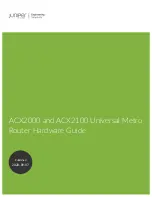
7
8
3.1.1 Switch S1
The table below shows the default configurations for Switch S1. A
description of all S1 options follows this table.
Switches S1-1, S1-2, and S1-3
Use Switches S1-1, S1-2 and S1-3 to set the DTE data rate.
Each setting represents an nx56/nx64 setting.
S1-1
S1-2
S1-3
Speed
Off
Off
Off
Clear Channel (Unframed)
On
Off
Off
112kbps/128kbps
Off
On
Off
224kbps/256kbps
On
On
Off
336kbps/384kbps
Off
Off
On
448kbps/512kbps
On
Off
On
672kbps/768kbps
Off
On
On
896kbps/1024kbps
On
On
On
1344kbps/1536kbps
Switch S1-4: Line Framing and Coding
Use Switch S1-4 to control the Network Line Framing and Coding
Options. Set these options to be the same as the Line Framing and
Coding Options given to you by your Service Provider. If you are using
two Model 2710RCs together as short range modems, set both units
identically.
S1-4
Line Framing & Coding
Off
ESF/B8ZS
On
D4/AMI
Line Framing Options:
D4/Superframe: The D4 framing format, as specified in AT&T
TR62411 is the standard in which twelve frames make up a
superframe. All signaling and synchronization are done in-
band.
Extended Superframe (ESF): Extended Superframe, as speci-
fied in AT&T TR 54016, consists of twenty-four (24) T1
frames. The framing bits are now used for framing, CRC and
the Facility Data Link (FDL). The FDL allows maintenance
messages and information to be passed between the 2710RC
and the Central Office.
Line Coding Options:
Alternate Mark Inversion (AMI): This mode does not inherently
account for ones density. To meet this requirement, each time
slot can be reduced to 56 kbps and the Least Significant Bit
(LSB) of each time slot set to one.
Bipolar 8 Zero Substitution (B8ZS): This mode assures proper
bit density in the data stream. In this mode any data pattern
can be transmitted without causing ones density errors. This
mode allows for 64 kbps clear channel timeslots.
Switch S1-5: DS0 Channel Rate
Use Switch S1-5 to set the DS0 rate.
SW1-5
Setting
Off
56 kbps
On
64 kbps
Switch S1-6 and S1-7: Clock Mode
Set Switch S1-6 and S1-7 to determine the 2710RC’s transmitter
timing.
S1-6
S1-7
Clock Mode
Off
Off
Network Clock. Transmitter timing is
derived from the received line signal.
On
Off
Internal Clock. Transmitter clock is
derived from an internal oscillator.
Off
On
External Clock. Transmitter clock is
derived from DTE interface.
S1 SUMMARY TABLE
Position
Function
Factory Default
Selected Option
S1-1
Data Rate
On
S1-2
Data Rate
On
S1-3
Data Rate
On
S1-4
Framing & Coding
Off
S1-5
DS Zero Rate
On
S1-6
Clock Mode
Off
S1-7
Clock Mode
Off
S1-8
Reserved
Off
1.536 Mbps
(DTE Rate)
ESF/B8ZS
64 kbps
Network
Reserved
Network






































